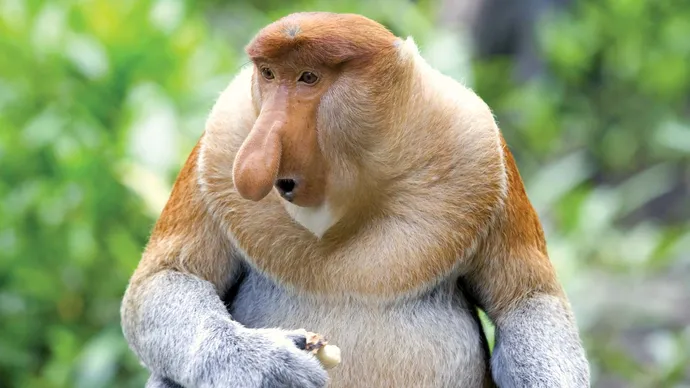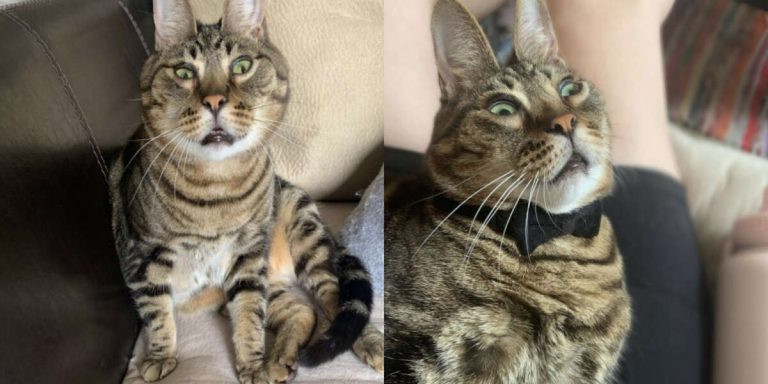Amazing Odd-Nosed Proboscis Monkey
The common proboscis monkey has a peculiar nose, as its name suggests. Although the name of the animal does not imply that any other part of its body is strange, the male of the species has a penis that can only be described as completely bizarre. The proboscis monkey, the Jimmy Durante of the animal world, has a nose like a banana, except it’s orange rather than yellow.
The monkey is cursed with a “pot belly, crazy voice box, and several other bizarre features, [which] once discovered… are never forgotten,” according to writer Brad Joseph. The stomach’s size is explained by its function: it acts as a “fermentation vat” in which “gut flora” convert “structural cellulose… into usable sugar” and detoxify poisonous alkaloids.

The nose can be explained easily or inexplicably. If scientists are correct in their assumption that the proboscis monkey’s proboscis is “attractive to females,” the former is true. If the scientists’ hypothesis is incorrect, the latter is more likely. But one thing is certain: the animal’s nose has an unmistakable presence. It’s not only there, but it’s impossible to overlook.
The penis of the proboscis monkey is another “unique and attention-getting characteristic of the monkey,” according to Joseph. “Always erect,” the cone-shaped scarlet member rearing aloft from a black scrotum constantly perspires as a means of releasing “excess sodium,” Joseph explains, a necessity for survival in the monkey’s “salty, mangrove forests.”

© Webitect/Fotolia
Personality and Way of Life
Proboscis monkeys are the most skilled swimmers in the primate world, frequently leaping from tree branches into the river and back out. Their webbed feet enable them to outswim aquatic predators such as crocodiles and to swim across deep waters in search of food or to avoid potential danger on land.
They are arboreal (tree dwellers) and generally avoid descending to the ground. They spend the majority of their time feeding, resting, and traveling.

Female troop members perform the majority of social grooming, which is primarily directed at infants. Adult males rarely groom themselves. The majority of allogrooming occurs while individuals are seated.
Proboscis monkeys coexist with surilis, gibbons, orangutans, langurs, macaques, slow lorises, and tarsiers, among other primate species. This means they share the same geographical ranges as the other species. If one of these species is encountered, proboscis monkeys usually ignore it and continue on their way.
Follow us on Pinterest

Because food resources overlap, there may be some competition between proboscis monkeys and sympatric species; however, aggressive behavior between species is uncommon.
Appearance
Males and females are sexually dimorphic in appearance as well as size, with the nose being the most distinguishing feature. Adult males’ noses hang down over their mouths and may even extend past their chins, measuring more than 4 inches (10 cm) in length and reaching up to 7 inches in length (17.5 cm).

© Kjersti/Fotolia
These enormous noses are used in sexual displays as well as as amplifiers, producing loud honking calls. Although female noses are large in comparison to other primates, they are much smaller in comparison to adult male noses and are slightly turned upward. Males and females’ noses are typically monkey-like in size at birth, and they develop into their signature larger noses as they mature.
Communication
Proboscis monkeys communicate using a variety of vocalizations, including honking, alarm calls, threat calls, infant calls, and female calls. Males will occasionally make growling noises, which are usually used to calm the group members. They honk to ward off predators or to warn a group of predators.

Honking can also be used to convey territorial information. Males honk at babies to reassure them and to convey information about group cohesion. Alarm calls differ between sexes, but males frequently emit these calls in dangerous situations. Females and juveniles use shrieks to express excitement or agitation. During agonistic encounters, screams occur.
Threats and Conservation Status

The International Union for Conservation of Nature Red List classifies the proboscis monkey as Endangered (IUCN, 2015). Borneo’s proboscis monkey population has declined over the last 40 years. There are fewer than 20,000 proboscis monkeys left in Borneo, which is made up of many small, isolated populations.
Proboscis monkeys are effectively restricted to forest strips along rivers and the interconnecting waterways of swamp forests and coastal mangroves due to their specific habitat requirements.
Read about:
Read about: Huge Humpback Whale Surprised it’s Watchers







